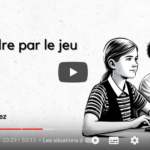Du 3 au 6 juillet 2017, le LIP s’est déplacé à Dublin pour participer à la conférence WCCE2017. Le LIP a en particulier organisé un symposium intitulé “Game-based learning and gamification of learning and instruction” et auquel ont également participé des chercheurs italiens et anglais. Ce symposium nous a permis de présenter les premières analyses des traces d’interaction recueillies dans des classes suisses qui utilisent Classcraft pour la gestion de classe.
- Bonvin, G., Sanchez, E. (2017) Social Engagement in a Digital Role-Playing Game dedicated to Classroom Management. Paper presented at the symposium “Game-based learning and gamification of learning and instruction”. World Conference on Computer in Education. Dublin, Ireland (5th July 2017).

Diapositives de la présentation
Abstract : Classcraft, available as a mobile and web application, is a role-playing game for classroom management in high schools [1]. Teachers can create teams and assign an avatar to students, as well as points and ‘powers’ as rewards for desired behaviour. By playing Classcraft, students are expected to help other students and to collaborate during school activities. Thus, Classcraft aims to foster players’ social engagement. We conducted a preliminary study on 6 classrooms from Switzerland. The objective of our study aims to characterize the social component of players’ engagement and its evolution.
Our approach is based on the identification of engaged-behaviors [1]. Bouvier et al. [2] consider that players’ engagement encompasses four components. The environmental component is in relation with the autonomy need, the social component is in relation with relatedness, the self component relates to the autonomy need and the action component is in relation with the competence and autonomy needs.
We developed a methodology based on learning analytics [3] to monitor players’ behavior. The detection of engaged-behaviors is based on the collection and analysis of players’ digital traces of players’ actions. Each action is automatically recorded and characterized by a type of event, a timestamp (beginning and end of the event) and information that is useful to derive meaning. Among the wide variety of the action performed, some are inherent to players’ social engagement and they are analysed with a specific digital platform, called kernel Trace Based System for Learning Analytics (kTBS4LA), dedicated to the analysis of digital traces.
Different categories of players emerged in terms of social engagement. In addition, the data collected shows that social engagement varies across time. This variation seems linked both to specific features of the game and to teachers’ decisions as game-master. This preliminary study also emphasizes some important methodological issues for addressing game-based learning with a methodology based on learning analytics.
References
- Sanchez, E., Young, S., Jouneau-Sion , C.: Classcraft: from gamification to ludicization of classroom management. Education and Information Technologies, 20(5), (2016)
- Bouvier, P., Lavoué, E., Sehaba, K., George, S.: Identifying Learner’s Engagement in Learning Games – A Qualitative Approach based on Learner’s Traces of Interaction. Paper presented at the 5th International Conference on Computer Supported Education, (2013)
- Siemens, G., Baker, R.: Learning Analytics and Educational Data Mining: Towards Communication and Collaboration. Proceedings of the 2nd International Conference on Learning Analytics and Knowledge, (2012)



